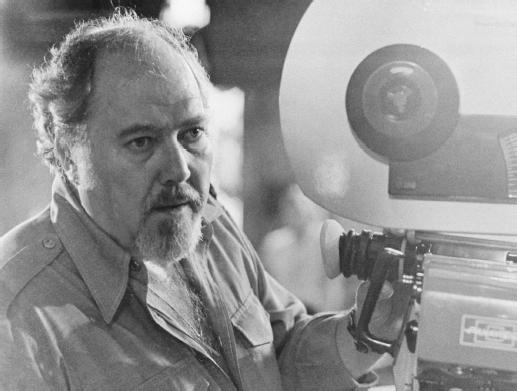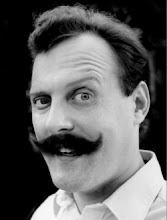
One of my favorite modern filmmakers, the
great Director Robert Altman has died, at 81.
Altman made mostly TV from 1951, with two features in 1957,
"The James Dean Story," and "The Delinquents," and in 1969
"That Cold Day In The Park," shot in Vancouver, BC.
Although he'd directed them, and many of my favorite TV shows,(like "Combat!," "Route 66," "Bonanza," "The Roaring 20's,""Surfside 6," "Lawman," "Maverick," "Sugarfoot," "U.S. Marshal,""The Millionaire," "Hawaiian Eye," "Whirlybirds," "Peter Gunn,""Alfred Hitchcock Presents," and a 1977 segment of "Saturday NightLive"), for me, his movie career begins with "M*A*S*H."
I got caught up in "M*A*S*H" in 1970, and watched it many,many times. Hundreds of times, actually, just to see how deliciously seamless was this anarchic collection of war anecdotes. In many ways, it's still Altman's best film. It was his biggest box office hit.
Hollywood said "M*A*S*H" couldn't be done.
Altman was the fifteenth Director
offered the project.
It said "Korea" at the top of "M*A*S*H," (at the insistence
of Fox, the studio), but it was obviously an anti-war movie
about all wars, most notably (then-current) Vietnam.
And funny! In my opinion, nobody in that film has done
better work, before or since.
I don't just watch movies.
I devour them. I study them.
I was studying "M*A*S*H" again recently. DVDs sure make it
easier now. Back and forth, forth and back, frame by frame.
In 1970, it wasn't quite so easy. I was a self-proclaimed
movie reviewer, 14 years old, a junior in high school.
I'd recently seen my first theatrical movie,
and was ruined for regular work.
My technique was to show up at movie theatres (standard or
drive-in) and show a little card I'd made on a Xerox machine.
They'd let me in, and I'd see the movie over and over, until I'd
absorbed it, and I'd go home and type my review, and mail it to
local newspapers.
A surprising number of them got printed. Getting printed got
much easier once I was in college. They let me write for their
newspaper, and I got access to a better Xerox machine.
Seeing movies got to be much easier when I got jobs as
projectionist and theatre manager, and easiest of all
when I bought my own theatre.
I first met Robert Altman in 1976. He'd made a movie called
"Nashville" the year before. I'd watched it more than 150 times.
Mr. Altman came to speak at my college, the University of
Washington, in an enormous concrete bunker called Kane Hall.
The hall seated several hundred comfortably, and was packed far
beyond capacity. Altman had come to speak, bringing with him
beautiful Sally Kellerman and his very talented protégé
Alan Rudolph, the Director of the film they were there
to plug, "Welcome To L.A." It was a fun film,
a real indy feel, music by Richard Baskin.
Altman talked about his career, and "Welcome To L.A." and
answered movie questions from the audience.
I asked one about "Nashville," wanting to know whether the
motorcade that starts the assassination sequence was an
intentional allusion to the 8mm Kennedy/Zapruder footage.
Altman smiled slyly and said yes, they'd set it up that way.
He said nobody had asked that yet.
I mentioned I'd watched it 150 times.
You would have thought I'd slapped him. He blinked, and his
eyes rolled, and he stepped back. I was startled for a moment.
Then he grinned, and said "150 times two bucks..."
(then-current movie admission price), pantomimed working
a cash register, and the audience roared with laughter.
I didn't have the heart to tell Mr. Altman I'd seen it that
many times for free, but it was clear to me he was a guy who
knew his Business, at least as well as he knew his Art.
I read his interview in Playboy magazine, where he
said he wrote scripts as bait, to get studio financing, but
would not be confined by them, when he actually made the
movie. His movies were based on an outline, but most
dialogue and action were improvised by Altman and his cast.
I read a similarly-published Playboy interview with Mike
Nichols, who said he was surprised to find himself only filming
things that were carefully written, improvising almost nothing.
(Considering that Nichols and his comedy partner Elaine May, and
their improv mom Viola Spolin, practically invented most of the
rules of what we know now as improvisational theatre, learning
Nichols now-sticks-rigidly-to-scripts was a revelation to me.)
What sticks out most from that interview was Mike Nichols saying
something to the effect of "The things I thought I'd be doing,
improvising whole movies, are now being done by Robert Altman."
I agree, and so does the Box Office. Compare Altman's
"M*A*S*H" with Nichols's "Catch-22," sometime.
(Both anti-war movies, both made the same year.)
"M*A*S*H" was made on a shoestring, with a great cast,
and jazzed with an incredible electricity. Hit!
"Catch-22" was incredibly expensive, with a great cast,
and...very clever, but only a couple of volts. Flop.
Nobody made movies like Robert Altman.
To be specific, nobody made bright, improvised movies,
working with an ensemble cast of similarly-bright actors
improvising brilliantly, better than Robert Altman.
The editing of his films was never short of incredible. It had to be.
Altman gave every Actor a microphone. Each mic fed a separate
track on his 2-inch, 15 ips, 40-track Stephens tape recorder.
That gave the cast complete freedom to improvise, knowing each Actor's words were preserved separately, even when their dialogue overlapped, and could be edited and mixed any way necessary, to present only words that moved the story along.
Altman's soundtracks can sound like a jumble sometimes, but if you listen, you'll understand just how much they are orchestrated and trimmed, shaped and sculpted, to allow only story to punch through.
Another thing he was great at was the use of the Panavision zoom lens. He zoomed sparingly, for a guy who'd shot so much television, but when a zoom was called for, Altman used it like a virtuoso.
(Kubrick mostly didn't shoot Anamorphic, but he was the other great zoomer.)
I loved (and devoured) Robert Altman's other '70s films too.
"Brewster McCloud" a strange allegory about a young man who wants to fly on bird wings in the Houston Astrodome; "McCabe and Mrs. Miller," a Pacific North Western set in the rainy Pacific Northwest;
"Images" where Susannah York goes crazy; "The Long Goodbye" with Elliot Gould as Raymond Chandler's Hollywood detective Philip Marlowe; "Thieves Like Us" Keith Carradine, John Schuck, and Bert Remsen as three escaped convicts; "California Split" George Segal and Elliott Gould gambol and gamble.
"Nashville," with Henry Gibson, beautiful Karen Black and Ronee Blakelee, goofy Jeff Goldblum, and Lily Tomlin, and Keith Carradine, who won an Oscar for his song "I'm Easy," of course;
"Buffalo Bill and the Indians" with Paul Newman as America's first superstar; and "A Wedding" which was, well, a wedding, only with a great ensemble Hollywood cast, and with Altman, great Hollywood Movie Director, taking the home movies.
Then I went Hollywood in 1978.
Long story, but I bought a bunch of Mr. Altman's 35mm sound
equipment, to take back with me to my home studio in Enumclaw.
He got better gear, and I gave his old machines a good home,
as long as I had them.
I saw fewer and fewer of his new releases, as I was trying to
learn my own chops, but I always enjoyed what I saw.
His movies were great.
I remember "3 Women," Altman's dope dream, and "Popeye,"
his kid's film, which I ran at my theatre.
1982's "Come Back to the Five and Dime, Jimmy Dean, Jimmy Dean," as Altman's great little 16mm theatrical adaptation of his Broadway production. I saw it in Portland, Oregon.
I remember the snooty Art crowd I was with, who laughed aloud when Cher's title credit came up. Cherilyn Sarkisian LaPierre Bono Allman was great in that picture. She was nominated for a Golden Globe, and has had a fine movie career ever since. Emmy, Oscar, Golden Globe, you name it. Go Cher!
1992's "The Player" was a great back-stab at Hollywood itself, with an ensemble cast of many top Hollywood stars, a murder story unfolding over a Hollywood studio backdrop.
Ya wanna know how Hollywood works? See it.
Catch the "ultimate tracking shot," at the beginning, complete with Actors discussing other movie tracking shots, like Orson Welles's "Touch of Evil," and Antonioni's "The Passenger," within the shot itself. Utterly delightful, a wicked satire.
1994's "Prêt-à-Porter" ("Ready To Wear") is a guilty pleasure picture, which all builds to a long runway of beautiful female nudes. Delightful!
I saw Robert Altman, for what I sadly realize now was the last time, at the Academy Awards in 2001. He'd received his fifth Oscar nomination, for "Gosford Park."
I talked to him about it, and he seemed happy, although the
irony of having to go to England to make a movie for almost
such an honor here, wasn't lost on him. He'd won the Golden
Globes Best Director Award that year, which has often meant
an Oscar win, but not this time. No Altman 2001 Oscar.
"Gosford Park" was Altman's biggest box-office hit,
after "M*A*S*H."
Robert Altman was one of the very best, but never got a
Best Director Oscar. He did get a Lifetime Achievement
Award, at the 2006 Academy Awards. Wish I'd been there.
Afterward, he revealed to the press that he had a heart
transplant some time back, and he worried he wouldn't
be hired again.
I can't check that, but it's in keeping with the
WWII bomber pilot who later made one of the best
anti-war films of all time. Change of heart, indeed.
I missed seeing "A Prairie Home Companion" this last year,
I've been so busy, but I will. Especially now.
What great films, what a great body of work.
Robert Altman, you were great. I salute you.
Cher
Popeye
Catch-22
Nashville
M*A*S*H
3 Women
Filmmaker
The Player
A Wedding
Ned Beatty
Karen Black
Filmmaking
Tim Robbins
Brion James
Gosford Park
Touch Of Evil
Henry Gibson
Robert Altman
Ronee Blakely
Long Goodbye
The Passenger
California Split
Peter Gallagher
Keith Carradine
Sally Kellerman
Thieves Like Us
Welcome To L.A.
Whoopi Goldberg
Brewster McCloud
A Prairie Home Companion
Prêt-à-Porter (Ready To Wear)
Come Back To The Five And Dime, Jimmy Dean, Jimmy Dean
